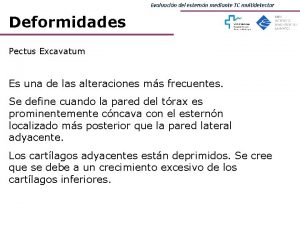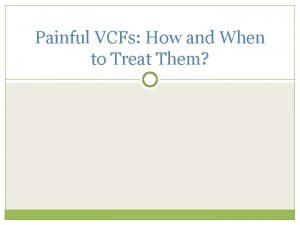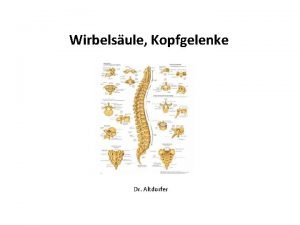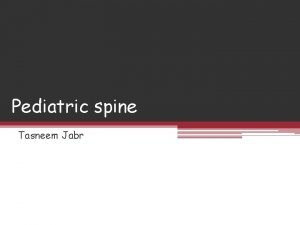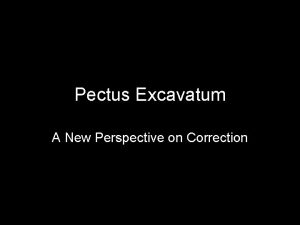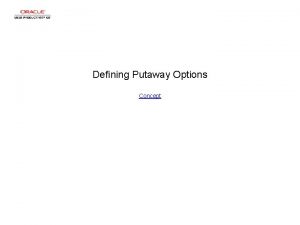Defining Thoracic Kyphosis in Patients with Pectus Excavatum












- Slides: 12

Defining Thoracic Kyphosis in Patients with Pectus Excavatum Elizabeth A. Berdan MD, A. Noelle Larson MD, Daniel A. Saltzman MD Ph. D, David W. Polly Jr. , MD CHEST WALL & SPINAL DEFORMITY STUDY GROUP UNIVERSITY OF MINNESOTA ICEOS November 2011

Case Presentation Patient LH is a 12 year old girl with kyphoscoliosis and pectus excavatum who presented to the Orthopaedic Clinic for correction of her severe kyphoscoliosis.

After surgical correction of her kyphoscoliosis her pectus excavatum deformity was enhanced. She was severely symptomatic with the acute decrease in her thoracic volume.

Before correction of kyphoscoliosis Increased pectus excavatum deformity With the acute decrease of space in her mediastinum after correction of her kyphosis this 12 year old was unable to ascend a flight of stairs without severe shortness of breath. This lead to the formation of a multidisciplinary study

Chest Wall &Spine Deformity Study Group University of Minnesota Department of Orthopaedic Surgery Charles Gerald T. Ledonio, MD David W. Polly, Jr. , MD Department of Pediatric Surgery Robert A. Acton, MD Donavan J. Hess, MD Daniel A. Saltzman, MD, Ph. D Department of General Surgery Elizabeth A. Berdan, MD Department of Pediatric Pulmonology Warren E. Regelmann, MD Department of Physical Medicine & Rehabilitiation David Nuckley, Ph. D Hanna Naegeli Department of Pediatric Radiology F. Glen Seidel, MD Mayo Clinic Department of Orthopaedic Surgery A. Noelle Larson, MD

Background Moderate scoliosis (greater than 30°) 1 out of 300 children Pectus malformation 1 out of 300 -400 children While scoliosis and pectus deformities are the most common malformations in children the interrelationship of spine and chest wall is not understood.

Our current study Hyperkyphosis may be a potential compensatory mechanism for increasing the thoracic volume in patients with pectus excavatum. Retrospective review 238 consecutive patients with pectus excavatum 79 patients with lateral chest x-rays

Measurement of Kyphosis Measure the Cobb angle from T 5 to T 12 238 consecutive patients 79 with standing lateral chest x- rays Compared to data from patients with adolescent idiopathic scoliosis

Results Thoracic Hypokyphosis (<10°) 16/79 = 20% Normal Thoracic Kyphosis (10 -40°) 61/79 = 77% Increased Kyphosis (>40°) 2/79 = 3%

Conclusions The thoracic kyphosis of patients with pectus excavatum is similar to that of scoliosis patients. Pectus deformity appears to exist independent from thoracic sagittal contour abnormalities.

Future Directions Evaluating the coronal plane alignment in patients with pectus Defining the prevalence of pectus deformity in children with scoliosis

This study is funded by a grant from The Chest Wall and Spinal Deformity Research Foundation
 Pectus incarnatum
Pectus incarnatum Pectus excavatum tc
Pectus excavatum tc Thoracic kyphosis
Thoracic kyphosis Kyphosis
Kyphosis Kyphosis symptoms
Kyphosis symptoms Gambar kifosis lordosis skoliosis
Gambar kifosis lordosis skoliosis Scheuermann's kyphosis
Scheuermann's kyphosis Defining and non defining relative clauses in telugu
Defining and non defining relative clauses in telugu Examples of non defining relative clauses
Examples of non defining relative clauses Non-defining relative clauses cümleleri
Non-defining relative clauses cümleleri Relative clauses defining and non defining
Relative clauses defining and non defining Nonessential relative clause
Nonessential relative clause Non defining
Non defining

